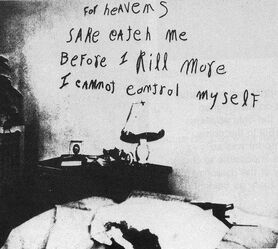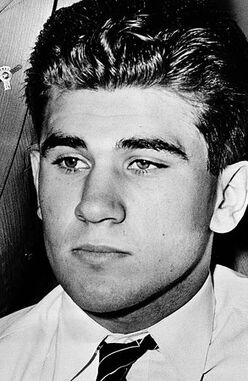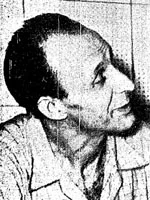| “ | For heavens sake catch me before I kill more I cannot control myself |
” |
— The Lipstick Killer
| ||
"The Lipstick Killer" was a serial killer and one-time abductor active in Chicago during the mid-to-late 1940s. Though a serial burglar named William Heirens confessed to the murders, he has since recanted his confession on the grounds that it was forced.
Case History[]

The message in Frances Brown's apartment.
The first murder attributed to the Lipstick Killer took place on the night of June 4, 1945. The victim was 43-year-old Josephine Ross, who was stabbed and her throat slit. The next victim, 33-year-old Frances Brown, was killed by a gunshot wound to the head, stabbed post-mortem and her body interacted with in a way similar to that of Ross. This time, the killer wrote a message on a mirror above the apartment's bed in the victim's lipstick: "For heaven's sake, catch me before I kill more, I cannot control myself". This led to him being nicknamed "the Lipstick Killer" in the media. On the night of January 7 the following year, six-year-old Suzanne Degnan was abducted from her family's apartment. She was taken to a nearby basement laundry room, where she was strangled to death and dismembered. Her body parts were then dumped in sewer drains and catch basins near the laundry room; police kept finding them for weeks afterward. The coroner estimated that she had died between 12:30-1:00 am. A poorly spelled ransom note telling the parents to pay $20 000 in five- and ten-dollar bills for the return of their daughter and not to contact the police or FBI was found in the apartment. The case attracted a great deal of media attention and spurred an intense manhunt by the authorities.
William Heirens[]

William Heirens.
William George Heirens was born in 1928 in Evanston, Illinois, but grew up in Lincolnwood, a suburb of Chicago, during the Great Depression. His parents had been in the floral business but lost it due to the state of the economy. Though he grew up in a relatively poor household, his upbringing was fairly normal. His father, George, was an odd-job laborer who often spent the small earnings he made on socializing with his friends. His mother, Margaret, worked at a bakery and often had to leave him and his three years younger brother, Jere, with babysitters. William was reportedly a loner and enjoyed playing with technical things, such as chemistry sets and toy airplanes, and also liked drawing and repairing old clocks. In order to escape the out-lashes of his parents' troubled marriage, he would usually leave the house and hang outside, eventually taking up burglary just for the sake of tension relief. The only thing he stole for financial reasons was small amounts of cash. The rest of his loot, which included expensive clothes, radios, and guns, he kept in a storage shed near where he lived.
At the age of 11, Heirens saw a couple having sex. When he told his mother about it, she told him that sex was dirty and led to diseases. Later, he burst into tears and vomited after kissing his girlfriend. At the age of 13, he was arrested for carrying a .25 handgun he had stolen. He confessed to his many burglaries and was sent to the Gibault School for wayward boys in Terre Haute, Indiana (which years later would also house Charles Manson). After months there, he was released and arrested for burglary again. He was sent to the St. Bede Academy, a Catholic college-preparatory high school, where he was an excellent student. In 1945, aged 16, he was released, having skipped his senior year. With good test scores, Heirens enrolled in the University of Chicago, majoring in electrical engineering and continued his serial burglaries. During his first year, things went well, even though his parents couldn't afford the tuition fees or the dorm fees, forcing him to do part-time work at night as well as doing burglaries for money. He eventually started stealing War Bonds as well. During his second year, his grades started slipping due to him starting dating and spending less time doing homework. In 1945, when Heirens was 17, the Lipstick Killer murders began.
On June 26, 1946, Heirens was caught trying to burglarize an apartment. Two officers, Constant and Owens, responded to the break-in and went into pursuit. As Heirens ran, he pulled out a gun and threatened Constant, who charged at him. A nearby off-duty officer, Cunningham, saw the fight and intervened, dropping three flower pots onto Heirens' head. Heirens later claimed that for the next six days, he was tortured, starved, and denied a lawyer by the Chicago police. At one point, he was administered sodium pentathol (commonly referred to as a "truth drug") without a warrant or consent. At the time, the authorities claimed that during this questioning, Heirens claimed that an alternate personality named "George Murman" had committed the murders. Heirens himself claimed not to remember much of the interrogation and the transcript disappeared. A psychiatrist who had taken part in the questioning claimed in 1952 that Heirens didn't say anything that implicated him in any of the murders. The police also searched his residence and dorm, again without a warrant, and didn't find anything that seriously incriminated him in the murders besides a scrapbook of Nazi officials Heirens had stolen from Harry Gold, a WWII veteran who lived near the Degnans, on the night of the Degnan murder. Though there was very little hard evidence implicating him in the murders, he was put on trial for them. The killings became a media sensation and Heirens was publicly declared the killer before he had even been found guilty; one headline read "The Heirens Story! How He Killed Suzanne Degnan and 2 Women".
One of the few pieces of evidence linking Heirens to the first two murders was a bloody fingerprint smudge found on the door jamb on the entrance door. It was compared to Heirens prints and was declared not a match. Twelve days later, it was announced to have matched by 22 points, but a fingerprint expert testified during the trial that it only matched no more than eight points. Two fingerprints and a palm print found on the ransom note were compared to Heirens' by the FBI, who found that they matched with nine points, three points too low to be declared a positive match. On August 7, Heirens confessed to all the Lipstick Killer murders (he later claimed to have gotten several details about the crime from reading the newspapers). In prison, he was a model inmate. In 1972, he became the first prisoner in the history of Illinois to earn a BA degree. He also took up several trades and helped several inmates get their GEDs. He spent the last years of his life incarcerated in the Hospital Ward of the Dixon Correctional Center minimum security prison, suffered from diabetes and was confined to a wheelchair.
There are people who believe he was innocent of the murders. According to social activist Dolores Kennedy, who in 1994 formed a forensic investigation team to review the evidence in the Lipstick Killer case, they found several inconsistencies (including the fact that the print from the Brown scene was apparently taken from a fingerprint card) and that Heirens' confessions didn't fully match the evidence. They also concluded that the handwriting of the lipstick message and that of the ransom note were not the same and that neither matched that of Heirens. In 2007, Heirens once again applied for parole and was denied it. On March 5, 2012, Heirens was found dead in his cell, apparently from natural causes.
Other Suspects[]

Richard Russell Thomas.
- Richard Russell Thomas
- Male nurse, occasionally posing as a surgeon
- Lived in Phoenix, Arizona, but was in Chicago when Degnan was murdered
- Had been in prison in Arizona for molesting one of his daughters at the time of the investigation of the Degnan murder
- Had previously been convicted of attempted extortion and also had a record for spousal abuse and burglary
- His handwriting was said to be "very similar" to that of the ransom note
- Freely confessed to killing Degnan (and later recanted it), but was let go when Heirens was arrested
- Hector Verburgh
- Janitor in the Degnans' apartment building
- Suffered severe beatings at the hands of the police during interrogation
- Didn't have enough English skills to even write the ransom note
- Successfully sued the Chicago police for the way he was treated
- Vincent Costello
- 16 years old at the time of Degnan's murder
- Had previously been arrested for armed robbery
- Attempted to con the ransom money from the Degnan family with the help of another boy named Theodore Campbell, who made several calls to them, eventually telling them to check the sewers, where Degnan's body parts were found
- When he and Campbell were arrested, their polygraph tests indicated that they had no actual knowledge of the murder, but used what they had heard the investigators say about the case on the street
Description(s)[]
- An eyewitness to the Ross murder claimed to have seen a "swarthy", dark-haired, slender man of ca. 190 lbs. walking through the building
- An eyewitness to the Brown murder claimed to have seen a nervous-looking man aged 35-40 and of ca. 140 lbs. leave the apartment shortly after gunshots were heard (though the mutilation and posing of the body would have taken some time)
- An eyewitness to the Degnan murder claimed to have seen a man walking towards the apartment building carrying a shopping bag. He described him as a man aged ca. 35 years old, 5' 9" tall and weighing 170 lbs.
- Dark hairs were found clutched in the hand of Josephine Ross, leading investigators to believe that she pulled them off of her killer
- A coroner noted that Degnan was dismembered very well and with no signs of hacking, suggesting that the perpetrator was extremely talented at cutting flesh.
- Handwriting analysts who examined the Degnan ransom note noted that it was written in a style similar to music notation, suggesting that the writer may have musical skills.
Modus Operandi[]
All victims attributed to the Lipstick Killer were women. The first two were in their 30s or 40s and were both killed in their apartments by an assailant who broke in. His third victim, six-year-old Susan Degnan, was abducted from her home, taken to a separate location and then killed. In the first two cases, the killer also ransacked the apartments but never stole anything valuable. All three victims were killed in different ways, but all were mutilated somehow post-mortem. In the cases of Josephine Ross and Frances Brown, the killer taped over the gashes in their bodies with adhesive tape and wrapped an article of clothing around their heads. Another recurring thing in the murders was tubs of some sort; Josephine Ross' body was washed in the bathtub in her apartment, Frances Brown's body was washed the same way and was found draped over the edge of the bathtub, and Suzanne Degnan was dismembered in a laundry tub with a hunting knife. According to some sources, the killer had a habit of urinating and defecating in the apartments. According to Signature Killers, Heirens had a habit of doing the same in apartments he burglarized as well as stealing women's underwear. After Suzanne Degnan was dismembered, the severed parts were put in storm drains and catch basins.
Known Victims[]
- 1945:
- June 4-5: Josphine Ross, 43 (stabbed and her throat slashed; her stab wounds were taped over)
- December 19-20: Frances Brown, 33 (fatally shot in the head, then stabbed post-mortem; her stab wounds were taped over)
- January 7, 1946: Suzanne Degnan, 6 (abducted, strangled, decapitated, and dismembered)
- Note: There have also been assumptions that the Lipstick Killer case, specifically the murder of Suzanne Degnan, was "likely connected" to the c. January 15, 1947, the murder of Elizabeth Short, a.k.a. "The Black Dahlia".
On Criminal Minds[]
- Season One
- "Extreme Aggressor" - The Lipstick Killer is among the first serial killers ever referenced on the show and referenced as William Heirens. In it, an accomplice of a serial killer sends a time-triggered virus to an abducted victim's email account, which wipes the hard drive, only leaving behind the text "For heaven's sake catch me before I kill more I cannot control myself", the same message the Lipstick Killer wrote on the mirror in Frances Brown's apartment. There is significant reason to doubt that Heirens was actually behind the three (or possibly four) murders attributed to the Lipstick Killer, namely that his confession was coerced while under the influence of sodium thiopental (once regarded as a “truth drug”, it is actually a barbiturate general anesthetic which only lowers inhibitions and produces a drugged-up state in a subject), much of his confession was attested to by police but denied by Heirens himself and a psychiatrist on-scene, the only physical evidence (two bloody fingerprints) were found not to be a match, and he didn’t fit the profile of the killer. However, official record still indicates that Heirens was the Lipstick Killer.
- "Unfinished Business" - While never directly mentioned or referenced in the episode, the Lipstick Killer and Heirens appear to be the inspiration for the episode's main unsub, Walter Kern, as well as a suspect and different unsub, Scott Harbin - Heirens, Kern, and Harbin all were serial burglars with knowledge and experience with electrical hardware, operated in major cities, and were arrested in the process of committing another pattern crime during their final arrests. With Kern, both he and The Lipstick Killer were serial killers who targeted female victims, broke into their homes before murdering them there, killed by strangulation (although the Lipstick Killer murdered by other means), had nicknames for their crimes, were active in a span of two consecutive years before going dormant, and made statements implying murders out of compulsion (Kern said to one victim he "had to" kill her and "can't stop it", the Lipstick Killer wrote in a lipstick message at a crime scene he "cannot control myself"). Both Kern and Heirens worked in numerous odd jobs and were reported to have suffered from mental health problems (Kern was depressed during the hiatus in his killings, Heirens was intolerant of intimacy and sex and alleged by police to suffer dissociative identity disorder). Both Harbin and Heirens were fetish burglars who stole women's underwear, were arrested at least twice, were released on parole in coincidence with a series of murders they were suspected of, and were convicted and imprisoned on charges of burglary and murder.
- Season Four
- "The Big Wheel" - While not directly mentioned or referenced in this episode, the Lipstick Killer appears to have been an inspiration for the episode's unsub, Vincent Rowlings - Both were serial killers who targeted women, stabbed them to death, wrote messages in red pleading for help to stop killing, and deviated away from their original M.O. in their last murder (the Lipstick Killer strangled a small girl, while Rowlings stabbed a gang banger).
- Season Eleven
- "Tribute" - The Lipstick Killer was referenced again as an example of infamous serial killers in Chicago. In those examples, William Heirens was referred to as the killer, and while his conviction has drawn criticism in the present day, it remains official on public record, making it difficult to fault the episodes' writers for repeating it.
- Season Fourteen
- "Family Tree" - While never directly mentioned or referenced in this episode, The Lipsticker Killer appears to be an inspiration for the episode's unsub, The Beaumont Unsub - Both are serial killers of women (although the unsub also targeted men too), killed by stabbing and strangulation, kidnapped at least one victim, dismembered victims postmortem, and left messages for the police begging to be stopped. In relation to prime suspect William Heirens, both had normal upbringings, became independent at a young age, and were zealous and paranoid in their personalities.
Sources[]
- Wikipedia's article about Heirens and the Lipstick Killer case
- TruTV Crime Library articles about Heirens and the Lipstick Killer case
- Signature Killers: Interpreting the Calling Cards of the Serial Murderer (1997)
- BlackDahliaSolution.org page mentioning the Lipstick Killer case
- Dolores Kennedy's Justice Denied article about Heirens
- Biometric Newsportal page about fingerprint points
- The Serial Killers episode about Heirens
- Chicago Tribune online article about Heirens' death
- Summary of Heirens's life by Radford University's Department of Psychology
